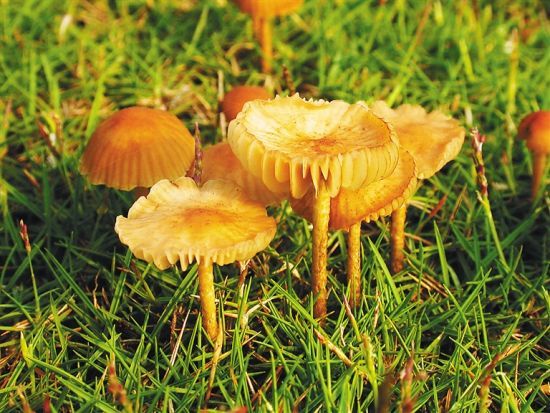基本介紹
- 中文名:海南小皮傘
- 拉丁學名:Aspergillus fimicola Kong et Qi sp. nov. (Anam.)
編號 | NFG-95-13 |
定名人 | 李泰輝 |
Nomencla | Kong Huazhong and Qi Zutong |
發表文章 | 廣東, 海南兩省小皮傘屬的種類 |
Article | Two New Species of Eurotium Isolated from Xizang (Tibat), China |
作者 | 李泰輝 畢志樹 鄭國楊 章衛民 |
Author | Kong Huazhong and Qi Zutong |
作者單位 | 廣東省微生物研究所, 廣州 510070 |
摘要 | 本文報 道廣東和海南省微皮傘屬 Marasmiellus Murr. 的種類 46種, 其中有一個新種和12個國內新記錄種。新種是海南 小皮傘 Marasmiellus hainanensis T.H.Li sp. nov. 文 中列有上述種類檢索表和新種的中文和拉丁文描述. |
Abstract | This paper reports two new species of eurotium link. 1. Eurotium fimicola sp. nov.: colonies on czapeck's agar atttaining a diameter of 6-12 mm after 18 days, conidial structures and cleistothecia limited . Colinies on W40S (wart agar with 20%sucrose) growing radidly, attaining a diameter of 70-75mm in 16 days at 25'C, conidial structuressparse, with surfaces appearing floccose, reaching a highness of4-5mm, nearly smoke gray (Ridgway PL XLVI); Cleistothecia more concentrated inthe central areas; no exudate; odour slightly mouldy; reverse orange yellow. Cleistothecia globose or subglobose, 90-150 micrometer in diameternearly orange Rufous, Burnt sienna or chestnut (Ridgway, pl.II); asci globose to subglobose, 10-13 micrometer in diameter, maturity in about21 days; ascorffaces, showing irregularly prominences, with 2 equatorial crests often showing a prominent band in the equatorial furrow.Conidial heads radiate, 80-120 micrometer in diameter; conidiophores arising from aerial hyphae, stipes 200-500 (-900) X (6.5-)8.0-12 micrometer,smooth-walled; vesicles globose, subglobose or flask-shaped, (10-)15--28(-32) micrometer in diameter, fertile all over or on the upperhalf; phialides 9.0-12 X 3.5-5.0 micrometer; conidia globose to ellipsoidal, 5.5-10 X 4.8-6.4 micrometer, smooth or roughened. No growth at 37'C. This species is cosely related to eurotium cristum and E.intermedium but it can be easily distinguished from the latter by its larger conidia, ascospores and more osmophilic ability. The specific epithet refers to the substratum isolated. This species was isolated from animal dung in xizang (tibet), China. Thetype specimen HMAS 62769 and living culture as 3.4674 aer deposited in the Institute of Microbiology, Academia Sinica, Beijing, China. 2. eurotium aridicola sp. nov.: Colonies on Czapeck's agar no germination of spores in 12 day at 25'C, attaining a diameter of 5-10mm in 30 days, conidiall structuresand cleistothecia limited colonies on W40S growing rapidly, attaining or diameter of 50-60mm in 10 days at 25'C; more conidial structures in the marginal or near marginal areas, withsurfaces appearing loosely floccose, nearly Mineral Gray (Ridgway, pl.XLVII); Cleistothecia more concentrated in the central areas, no exudate; odourlacking; reverse yellow in the central ares, light gray in the other areas. Cleistothecia globose to subglobose, (60-)70-90 micrometer indiameter, nearly Aniline Yellow (Ridgway pl.IV); asci globose to subglobose, 11-13 micrometer, in diameter, maturity in duameter, maturity in about14 days; ascospores lenticular 5.5-6.5 X 4.0-5.0 micrometer, convex surfaces smooth or nearly so, with 2 equatorial crests, about 0.5-0.8micrometer broad, often showing aprominent band in the equatorial furrow. Conidial heads appearing radiate, 80-130 micrometer in diameter;conidiophores arising from substratum or aerial hyphae, stipes (50-)150-400 X 8.0-14 (-16) micrometer, smooth-walled; vesicles globose to subgobose,flack shaped, (10-)16-30 micrometer in diameter, fertile, fertile all over or on the upper half only; phialides 9.5-12(-14) X 4.0-5.5 (-6.5)micrometer; conidia globose to subglobose, 5.0-8.0(-10) micrometer, less commonly ellipssoidal or ovall, 6.5-10 (-12) X 5.5-8.0 micrometer, echinulate. Growth well at 37'C. This species shows some similarities to Eurotium chevalieri. However it can be easily destinguished from the latter by its more osmophilic ability, llarger conisia and ascospores. The species epithet refers to the character of its osmophilic ablity of the fungus. This fungus was isolated from sheep dung in Xizang, China. The type sppecimwn HMAS 62768 and living culture AS 3.4673 are deposited in the Institute of Microbiology, Academia Sinica, Beijing, China. |
關鍵字 | 小皮傘屬, 南小皮 傘 |
Key | - |
期刊 | 真菌學報 13(4):249-254, 1994 |
Publication | Acta Mycologica Sinica (Chinese; English Abstract), 14(2):pp.86-91, 1995 |
分享省市 | 海南省樂東縣 |
Place | Dingri County, Tibet Autonomous Region, |
採集地 | 群生於闊葉林中單子 葉植物腐枝上或其它植物體上 |
Environment | The specimen collected from the animal dung near Jumulangma Park at Ximalaya Mountain. |
海撥高度 | - |
生態環境 | 熱帶季風氣候針闊混交林 |
寄主 | 單子葉植物腐枝上或其它植物體上 |
Habitat | superland temperate monsoon climate biological flora |
Host | animal dung |
採集人 | 陳煥強 |
Isolation Person | Zhuang Jianyun et al. |
採集時間 | - |
保存單位 | 廣東省微生物研究所真菌標本室, 廣州 510070 |
Preservation Unit | Herbarium of Mycology, Institute of Microbiology, The Chinese Academy of Sciences, Beijing 100080, China / |
描述 | - |
等模式 | - |
Speciman No. | HMAS 62769 |
全文 | - |
Note | The living culture AS 3.4674 deposited in the Chinese Common Culture Collection of Microorganisms, Institute of Microbiology, The Chinese Academy of Sciences, Beijing 100080, China |

